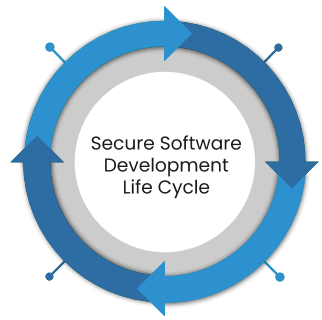As a result of the expansion of remote jobs, online businesses, and digital lifestyles, applications have become an integral component of our daily lives. Data breaches and cyberattacks utilizing minor vulnerabilities in programs functioning are becoming more common throughout the globe.

Many organizations disregard the necessity of securing customers’ privacy and data in favor of applications with various functions. However, this does not diminish the importance of security activities in the project, whether the findings of an application penetration test, a secure code review, or any other kind of security validation exercise.
To restrict application design and architecture vulnerabilities, the development team must follow security principles with explicit knowledge when planning, producing, and delivering software, using key practices such as DevSecOps by JFrog. This is where the Secure Software Development Life Cycle (SDLC) enters the picture.
What Is SDLC?
The Software Development Life Cycle (SDLC) is a rigorous, iterative, and coordinated process for developing software applications. It consists of the phases of planning, analyzing, designing, creating, testing, deploying, and supporting the system. The waterfall model, the spiral model, and the ever-popular agile model are among the SDLC models available.
SDLC Best Practices
There are certain highly recommended practices that you should put in place to maintain SDLC security.
• Change Your Mindset to Adopt DevSecOps
DevSecOps encourages security teams to alter their standard security processes and procedures to react to emerging threats more effectively. Although it may seem straightforward at first glance, changing established systems, attitudes, or cultures, especially in large businesses, is never simple.
Adhering to the DevSecOps idea requires instilling a security-conscious culture and mindset across the whole application development and deployment process. This implies that outmoded security methods must be replaced with more agile and flexible ways for security to adapt to the rapidly changing environment.
• Apply Common Sense to Threat Modelling
Threat modeling is the process of looking at the architecture of systems, how they function, and how data flows inside and between all system components at the earliest possible stage of the software development life cycle. The purpose of threat modeling is to identify all possible channels for system exploitation. When threat modeling is performed, it ensures that architectural design and development can take into account all of the security risks that have been identified.
However, threat modeling often takes a significant amount of time to complete since it requires the input of a human to identify all possible entry points for an attack.
• Limit Access to Code Repositories
Assaults on supply chains were a major concern in 2021, and code repositories were often targeted. Cyberattacks gained access to SolarWinds’ development environment and inserted malicious functionality into the update code for the company’s Orion product, which resulted in a significant breach at the company.
It is critical to include security in the development process to guarantee code safety, but this will be useless if attackers get access to the development environment and install their risky code. Without access control for code repositories, application security cannot be deemed comprehensive. Only corporate identities that have been authorized should be able to contribute code to a company’s repository. It will be far more difficult for a hacker to impersonate a developer and install dangerous code as a result of this.
• Ensure Proper Training
All of the organization’s developers, designers, architects, and quality assurance teams must get security training. They might study secure design principles, security problems, internet security, or encryption, among other things. Security awareness training is not just for the development team; it is for everyone inside the company who is involved in the project in any manner. The sessions’ technical complexity should be kept to a minimum, and viable topics for discussion include various sorts of cybersecurity threats, as well as the impact and management of risks.
• Address Vulnerabilities
The software will always contain vulnerabilities, and these flaws may be found in a variety of ways, including by your customers, security researchers, or criminal actors. When vulnerabilities in an organization’s software are discovered, it is expected that the company will respond quickly. If a software development organization is aware of a vulnerability but does nothing to solve it, its image may suffer significantly.
A Vulnerability Disclosure Plan (VDP) and its related policies provide an organizational mechanism for investigating newly identified vulnerabilities, quickly deciding remedial measures, implementing those actions, and testing software updates to ensure that the vulnerability has been patched. With the help of a VDP, your firm may be able to get a head start on planning for the next major vulnerability.
